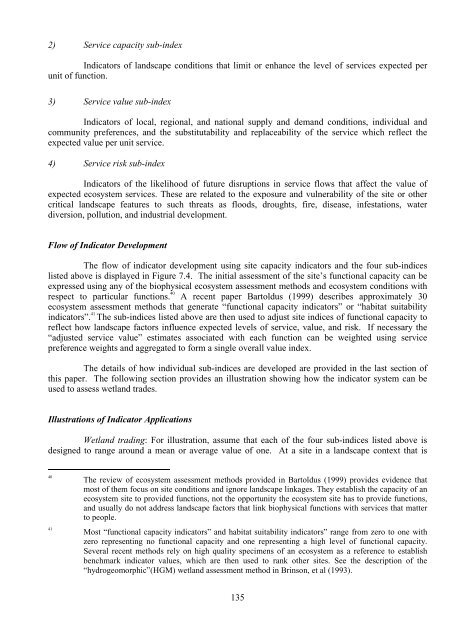Valuation of Biodiversity Benefits (OECD)
Valuation of Biodiversity Benefits (OECD)
Valuation of Biodiversity Benefits (OECD)
- No tags were found...
You also want an ePaper? Increase the reach of your titles
YUMPU automatically turns print PDFs into web optimized ePapers that Google loves.
2) Service capacity sub-indexIndicators <strong>of</strong> landscape conditions that limit or enhance the level <strong>of</strong> services expected perunit <strong>of</strong> function.3) Service value sub-indexIndicators <strong>of</strong> local, regional, and national supply and demand conditions, individual andcommunity preferences, and the substitutability and replaceability <strong>of</strong> the service which reflect theexpected value per unit service.4) Service risk sub-indexIndicators <strong>of</strong> the likelihood <strong>of</strong> future disruptions in service flows that affect the value <strong>of</strong>expected ecosystem services. These are related to the exposure and vulnerability <strong>of</strong> the site or othercritical landscape features to such threats as floods, droughts, fire, disease, infestations, waterdiversion, pollution, and industrial development.Flow <strong>of</strong> Indicator DevelopmentThe flow <strong>of</strong> indicator development using site capacity indicators and the four sub-indiceslisted above is displayed in Figure 7.4. The initial assessment <strong>of</strong> the site’s functional capacity can beexpressed using any <strong>of</strong> the biophysical ecosystem assessment methods and ecosystem conditions withrespect to particular functions. 40 A recent paper Bartoldus (1999) describes approximately 30ecosystem assessment methods that generate “functional capacity indicators” or “habitat suitabilityindicators”. 41 The sub-indices listed above are then used to adjust site indices <strong>of</strong> functional capacity toreflect how landscape factors influence expected levels <strong>of</strong> service, value, and risk. If necessary the“adjusted service value” estimates associated with each function can be weighted using servicepreference weights and aggregated to form a single overall value index.The details <strong>of</strong> how individual sub-indices are developed are provided in the last section <strong>of</strong>this paper. The following section provides an illustration showing how the indicator system can beused to assess wetland trades.Illustrations <strong>of</strong> Indicator ApplicationsWetland trading: For illustration, assume that each <strong>of</strong> the four sub-indices listed above isdesigned to range around a mean or average value <strong>of</strong> one. At a site in a landscape context that is4041The review <strong>of</strong> ecosystem assessment methods provided in Bartoldus (1999) provides evidence thatmost <strong>of</strong> them focus on site conditions and ignore landscape linkages. They establish the capacity <strong>of</strong> anecosystem site to provided functions, not the opportunity the ecosystem site has to provide functions,and usually do not address landscape factors that link biophysical functions with services that matterto people.Most “functional capacity indicators” and habitat suitability indicators” range from zero to one withzero representing no functional capacity and one representing a high level <strong>of</strong> functional capacity.Several recent methods rely on high quality specimens <strong>of</strong> an ecosystem as a reference to establishbenchmark indicator values, which are then used to rank other sites. See the description <strong>of</strong> the“hydrogeomorphic”(HGM) wetland assessment method in Brinson, et al (1993).135












